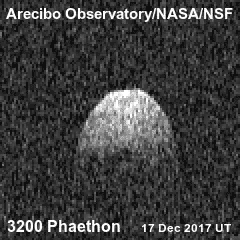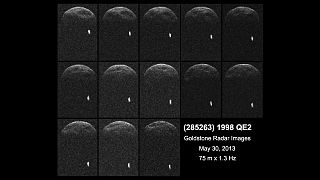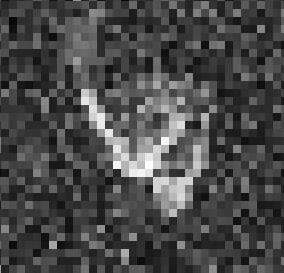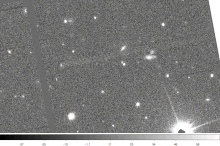
3200 Phaethon, provisionally designated 1983 TB, is an active Apollo asteroid with an orbit that brings it closer to the Sun than any other named asteroid. For this reason, it was named after the Greek myth of Phaëthon, son of the sun god Helios. It is 5.8 km (3.6 mi) in diameter and is the parent body of the Geminids meteor shower of mid-December. With an observation arc of 35+ years, it has a very well determined orbit. The 2017 Earth approach distance of about 10 million km was known with an accuracy of ±700 m.

2007 TU24 is an Apollo near-Earth asteroid that was discovered by the Catalina Sky Survey in Arizona on 11 October 2007. Imaging radar has estimated that it is 250 meters (820 ft) in diameter. The asteroid passed 554,209 kilometer (344,370 mile or 1.4-lunar distance) from Earth on 29 January 2008 at 08:33 UTC. (At the time of the passage it was believed the closest for any known potentially hazardous asteroid (PHA) of this size before 2027, but in 2010 2005 YU55 was measured to be 400 meters in diameter.) At closest approach the asteroid had an apparent magnitude of 10.3 and was about 50 times fainter than the naked eye can see. It required about a 3-inch (76 mm) telescope to be seen.

3122 Florence is a stony trinary asteroid of the Amor group. It is classified as a near-Earth object and potentially hazardous asteroid. It measures approximately 5 kilometers in diameter. It orbits the Sun at a distance of 1.0–2.5 AU once every 2 years and 4 months ; the orbit has an eccentricity of 0.42 and an inclination of 22° with respect to the ecliptic. Florence has two moons.

(450894) 2008 BT18 is a sub-kilometer asteroid and synchronous binary system, classified as near-Earth object and potentially hazardous asteroid of the Apollo group. It was discovered on 31 January 2008, by the LINEAR program at Lincoln Laboratory's Experimental Test Site near Socorro, New Mexico, United States. The eccentric asteroid measures approximately 600 meters in diameter and has a composition of a basaltic achondrite.

(308635) 2005 YU55, provisionally named 2005 YU55, is a potentially hazardous asteroid 360±40 meters in diameter, as measured after its Earth flyby. Previously it was estimated to be 310 meters or about 400 m (1,300 feet) in diameter. It was discovered on 28 December 2005 by Robert S. McMillan at Steward Observatory, Kitt Peak. On 8 November 2011 it passed 0.85 lunar distances (324,900 kilometers; 201,900 miles) from Earth.

2012 BX34 is a small Aten asteroid that made one of the closest recorded asteroid close approaches of Earth on 27 January 2012. It passed within 0.0004371 AU (65,390 km; 40,630 mi) of Earth during its closest approach at 15:25 GMT. 2012 BX34 measures around 8 meters (26 ft) across; if it had impacted in 2012, it would have been too small to pass through Earth's atmosphere intact.

367943 Duende (provisional designation 2012 DA14) is a micro-asteroid and a near-Earth object of the Aten and Atira group, approximately 30 meters (98 ft) in diameter. It was discovered by astronomers of the Astronomical Observatory of Mallorca at its robotic La Sagra Observatory in 2012, and named for the duende, a goblin-like creature from Iberian and Filipino mythology and folklore. Duende is likely an uncommon L-type asteroid and significantly elongated. For an asteroid of its size, it has a relatively long rotation period of 9.485 hours.
(471240) 2011 BT15, provisional designation 2011 BT15, is a stony, sub-kilometer sized asteroid and fast rotator, classified as a near-Earth object and potentially hazardous asteroid of the Apollo group. It had been one of the objects with the highest impact threat on the Palermo Technical Impact Hazard Scale.

(285263) 1998 QE2, provisional designation 1998 QE2, is a dark asteroid and synchronous binary system, classified as near-Earth object and potentially hazardous asteroid of the Amor group, approximately 3 kilometers in diameter. It was discovered on 19 August 1998, by astronomers of the LINEAR program at Lincoln Laboratory's Experimental Test Site near Socorro, New Mexico, in the United States. Its sub-kilometer minor-planet moon was discovered by radar on 30 May 2013.

(192642) 1999 RD32, provisional designation: 1999 RD32, is an asteroid and suspected contact binary on an eccentric orbit, classified as a large near-Earth object and potentially hazardous asteroid of the Apollo group, approximately 5 kilometers (3 miles) in diameter. It was discovered on 8 September 1999, at a magnitude of 18, by astronomers of the LINEAR program using its 1-meter telescope at the Lincoln Laboratory's Experimental Test Site near Socorro, New Mexico, United States. The asteroid is likely of carbonaceous composition and has a rotation period of 17.08 hours.

2014 HQ124 is a sub-kilometer asteroid, classified as near-Earth object and potentially hazardous asteroid of the Aten group, approximately 400 meters (1,300 feet) in diameter. It passed 3.25 lunar distances (LD) from Earth on 8 June 2014. It was discovered on 23 April 2014 by NEOWISE. It is estimated that an impact event would have had the energy equivalent of 2,000 megatons of TNT and would have created a 5 km (3 mi) impact crater. The news media misleadingly nicknamed it The Beast. 2014 HQ124 previously passed this close to Earth in 1952 and will not again until at least 2307. Radar imaging suggests it may be a contact binary.

(357439) 2004 BL86 is a bright sub-kilometer asteroid and binary system, classified as near-Earth object and potentially hazardous asteroid of the Apollo group, approximately 300 meters (980 ft) in diameter. It was discovered on 30 January 2004 by astronomers of the Lincoln Near-Earth Asteroid Research at Lincoln Laboratory's Experimental Test Site near Socorro, New Mexico. Its 70-meter (200 ft) moon was discovered during the asteroid's close approach to the Earth in January 2015.
2014 SC324 is a sub-kilometer asteroid and fast rotator, classified as a near-Earth object of the Apollo group, approximately 50 meters in diameter. It was first observed on 30 September 2014, by the Mount Lemmon Survey at an apparent magnitude of 21 using a 1.5-meter (59 in) reflecting telescope. With an absolute magnitude of 24.3, the asteroid is about 37–85 meters in diameter.

2012 TC4 is a tumbling micro-asteroid classified as a bright near-Earth object of the Apollo group, approximately 10 meters (30 feet) in diameter. It was first observed by Pan-STARRS at Haleakala Observatory on the Hawaiian island of Maui, in the United States. As of 1 October 2017, it had a small Earth minimum orbital intersection distance of 0.000149 AU (22,300 km). On 12 October 2017, it passed Earth at 0.00033524 AU (50,151 km). The asteroid was removed from the Sentry Risk Table on 16 October 2017 and with a 5-year observation arc has a well-known orbit. For example, on the previously risk-listed date of 12 October 2022, it is now known that the asteroid will be more than 3 AU (450 million km) from Earth.

460P/PanSTARRS (also known with the provisional designation P/2016 BA14) is a near-Earth object and periodic comet of the Jupiter family, with an orbital period of 5.25 years. In March 2016 it passed at distance of 2.2 million miles (3.5 million km, or 9 lunar distances) from Earth. It was the closest approach by a comet since 1770 and 3rd closest recorded comet to Earth. The close flyby enabled the size of the nucleus to be calculated at about 1 km (0.62 mi) in diameter, which was much bigger than expected. The comet is very dark, reflecting about 2-3 percent of the visible light, about the same as a charcoal briquette. It has a very similar orbit as numbered comet 252P/LINEAR, and may be related to it (e.g. split off of).

2014 JO25 is a near-Earth asteroid. It was discovered in May 2014 by astronomers at the Catalina Sky Survey near Tucson, Arizona - a project of NASA's NEO (Near Earth Object) Observations Program in collaboration with the University of Arizona.

(163899) 2003 SD220 is a sub-kilometer asteroid and tumbling slow rotator, classified as near-Earth object and potentially hazardous asteroid of the Aten group, which orbit the Sun between Venus and Earth. Its orbital period of 0.75 years means that it orbits the Sun about 4 times for every 3 of the Earth. It was discovered on 29 September 2003, by astronomers of the Lowell Observatory Near-Earth-Object Search at Anderson Mesa Station near Flagstaff, Arizona.

(505657) 2014 SR339, provisional designation 2014 SR339, is a dark and elongated asteroid, classified as near-Earth object and potentially hazardous asteroid of the Apollo group, approximately 970 meters (3,200 feet) in diameter. It was discovered on 30 September 2014, by NASA's Wide-field Infrared Survey Explorer telescope (WISE) in Earth's orbit. Closely observed at Goldstone and Arecibo in February 2018, it has a rotation period of 8.7 hours.

2017 VR12 is a sub-kilometer asteroid with a somewhat elongated and angular shape, approximately 160 meters (500 feet) in diameter. It is classified as near-Earth object and potentially hazardous asteroid of the Apollo or Amor group. The V-type asteroid has a rotation period of approximately 1.5 hours. It was first observed on 10 November 2017 by the 60-inch Pan-STARRS 1 telescope at Haleakala Observatory in Hawaii.

(85990) 1999 JV6, provisional designation 1999 JV6, is a sub-kilometer near-Earth asteroid and a potentially hazardous object of the Apollo group. It was discovered by astronomers of the LINEAR program at the Lincoln Laboratory's Experimental Test Site near Socorro, New Mexico. 1999 JV6 is a contact binary object consisting of two distinct lobes, as seen in radar images from various observatories including Arecibo and Goldstone in January 2015.



























